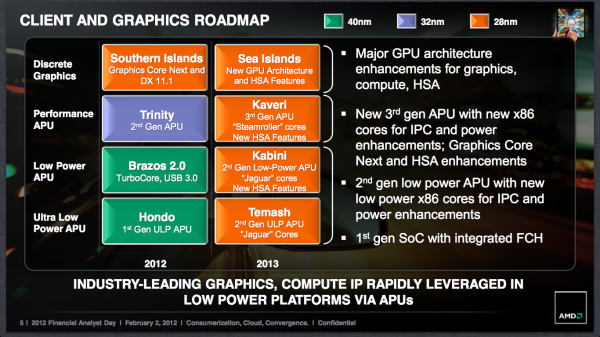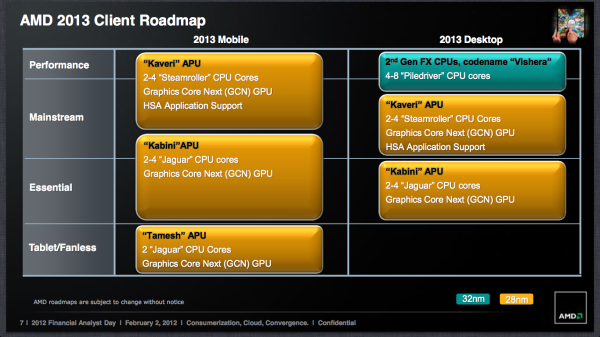Understanding AMD's Roadmap & New Direction
by Anand Lal Shimpi on February 2, 2012 6:16 PM EST- Posted in
- CPUs
- AMD
- Trade Shows
- AMD FAD 2012
We've been providing live coverage of AMD's 2012 Financial Analyst Day from Santa Clara today, but if you want a summary of the company's strategy under new CEO Rory Read you've come to the right place. Below you'll find links to everything we've published from AMD's FAD 2012:
AMD's Rory Read Outlines AMD's Future Strategy
AMD Outlines HSA Roadmap: Unified Memory for CPU/GPU in 2013, HSA GPUs in 2014
AMD is Open to Integrating 3rd Party IP in Future SoCs
AMD's Financial Analyst Day 2012 - Mark Papermaster, SVP & CTO Presentation
AMD: Flexible Around ISA
AMD Nods at Shorter Design Cycles, More Synthesized Designs
What AMD Views as Important: Tablets, Servers, Notebooks & GPUs
AMD & Compal Show Off 18mm Trinity Notebook
AMD's 2012 - 2013 Client CPU/GPU/APU Roadmap Revealed
AMD's 2012 - 2013 Server Roadmap: Abu Dhabi, Seoul & Delhi CPUs
AMD is Ambidextrous, Not Married to Any One Architecture, ARM in the Datacenter?
AMD's Tablet Architectures: Hondo at 4.5W, Future Sub-2W SoC
The name of the game for AMD in 2012 is execution. Far too often at previous AMD events we'd see a roadmap with no indication of whether or not AMD would actually stick to it. Plans were always aggressive and made sense, but execution rarely mirrored what was promised on paper. AMD in turn ended up delivering CPUs sometimes years after they were promised, which obviously didn't help grow the company.
Over the past few months Rory and his new management team at AMD have been restructuring the company to improve execution. As a much smaller company than Intel, AMD had an almost impossible task competing in the x86 space, but AMD should have also been far more agile than it was given its size. AMD's restructuring is supposed to fix these agility and execution problems. The proof will be in how well AMD is able to introduce products over the next 24 months.
As far as the roadmap goes, AMD already laid out what it hopes to accomplish by 2013. The best way to summarize AMD's next two years is: APUs and servers. On the APU side, we'll get updates to all of the current lines this year (Trinity & Brazos 2.0), but we'll also get a new 4.5W APU (Hondo) aimed at the Windows 8 tablet market. Now 4.5W is a bit high for a tablet but AMD has plans to bring even lower power architectures to market in the future. Next year we'll also see the first single-chip solutions from AMD: Kabini and Temash will integrate the I/O controller (SATA, USB ports, etc...) on-die. Intel is doing something similar with Haswell.
The big transition will happen next year, as AMD moves its entire APU stack from 32nm SOI to a bulk 28nm process at Global Foundries. This is an important move as it signifies the use of more easily synthesized designs, which enables AMD to bring out APUs in a quicker fashion and with lower design costs. Effectively everything follows the path laid by Brazos/Bobcat at this point. Note that AMD will be shipping 28nm APUs while Intel is well transitioned to 22nm, a gap that AMD has no intentions on narrowing. The process technology gap has almost always existed between AMD and Intel, but now AMD is taking a firm stance in saying that it has no intentions to blindly pursue the closing of that gap.
What once was a 3+ year design cycle for AMD CPUs and APUs now shrinks to less than 24 months (maybe even as short as 18 months) as a result of this migration to more easily synthesized designs. If this sounds a lot to you like the old GPU design cadence don't be surprised. AMD's APUs are, after all, largely made of GPU transistors that have always strayed from custom logic where possible. The big change is simply doing more non-custom x86 design.
Obviously AMD's ability to execute on this roadmap will depend heavily on Global Foundries delivering good yields at 28nm, however AMD does seem fairly confident at this point. That being said, 2013 is a very broad timeframe. Executing on the above roadmap sooner rather than later in 2013 will be the difference between a competitive AMD and one that's quickly written off.
I don't believe a move towards easily synthesized architectures is necessarily a bad thing. As long as AMD can deliver good performance at competitive prices the process technology really doesn't matter as much. Typically process technology was used as an enabler of good performance but as a newly fabless semiconductor, that strategy doesn't necessarily apply to AMD - at least not across all market segments. In other words, what works for Intel may not work for AMD.












84 Comments
View All Comments
spidey81 - Thursday, February 2, 2012 - link
There's nothing about what I asked that suggested AMD pander to the so called "high end". But they have been going for the mainstream enthusiast market with their unlocked CPU's. I don't have an unlimited budget and the most I've spent on a CPU or GPU is $300. I'm just hoping I'll see some better competition in the "value" enthusiast segment.Sabresiberian - Friday, February 3, 2012 - link
I certainly would have agreed at the time I built my systems that the cost/performance value favored AMD's Phenom II. I even recommended tit over the 1366 based platform to people building new computers, because they could not afford spending the extra money.However, I was an early adopter of Nehalem, and paid a premium for what I got. Today isn't yesterday, we have an extensive Sandy Bridge lineup to choose from, and AMD's offerings don't hold up.
As an example, I direct you to this article:
http://www.tomshardware.com/reviews/gaming-fx-pent...
The article is gaming oriented, and many Anandtech.com readers don't fit in that category, but even so I think it is of interest to those building or buying a new computer for any purpose. The fact is, AMD isn't just "losing" the performance "war", it is losing the cost effectiveness war as well. (I don't want downplay the fact that gaming benchmarks can have little to do with other needs, but if you really check prices and benchmarks for more business-oriented applications I think you'll find I'm not far off the mark there, too, for desktop CPUs.)
I suggest that far more than 5% of users would benefit from using an Intel offering over an AMD at any price point.
;)
wumpus - Wednesday, June 27, 2012 - link
First, the last Intel CPU I've used was a P3 base Celery. Looks I'll be going to Intel sooner or later.Two exceptions:
First, those of us with AM3+ sockets will have to decide if a new motherboard is worth it. This changes the value calculations enough for the 5%.
Second, I suspect Anandtech readers get roped into "supporting" more computers than they use outright. Even on the desktop, llanos-type CPUs will become more and more appropriate for any purchase not based on geek lust.
riottime - Thursday, February 2, 2012 - link
i'll wait until steamroller to upgrade my amd build. i plan to get ivy to upgrade my intel build. i will skip 7xxx series graphic cards and stick with my 5xxx series for both my amd and intel builds. they're still good. ;)Taft12 - Thursday, February 2, 2012 - link
"will the consumer market ever see anything directed at the desktop enthusiast marker?"Yes -- high-end gaming cards.
Rory Read and Anand made it very clear. The war is over for the high-end desktop. Intel won. But that market barely exists anymore - at least not in volumes that AMD or Intel care about, despite the high margins of i7 and FX CPUs
Neither will be investing much R&D there anymore. Look on the bright side, at least your Sandy Bridge system is future proof in the sense that neither company will produce something any better to tempt you to upgrade.
SlyNine - Thursday, February 2, 2012 - link
LOL, you talk as if it ever was a big market for it. Sorry to ruin your whole post by saying nothing has changed.EyelessBlond - Friday, February 3, 2012 - link
It has, though. I used to spend a decent amount of money on the CPU for my PC, and upgraded every couple of years. Nowadays, when I scrape together a few hundred dollars to upgrade my system I'm looking at a third/fourth/sixth monitor, an SSD, a good mechanical keyboard/gaming mouse, a better GPU. The CPU just isn't that important any more; now that a good quad/hex-core from two years ago can keep my system running strong, I can focus on other priorities.jabber - Friday, February 3, 2012 - link
Spot on. As soon as dual cores appeared it was game over in terms of CPU power needs for most folks.I now go longer and longer between CPU upgrades. I also don't even bother looking at anything higher than $150 for my needs. I have better things to do than run bechmarks all day. I'd rather spend the money as you say on a better monitor or something I'll really notice like a SSD.
I used to buy Opterons/DDR500/Raptors etc. but now I just don't find that stuff really matters now.
Ultimate performance items contribute very little to the overall average user experience.
SlyNine - Saturday, February 4, 2012 - link
Yea but I'm talking about the ultra high end 1000$ CPU market. when you could buy 90% of that speed for 200$. That market was never big.I do agree though. The important segment, mid range, has dropped off because older CPU's are still fast enough. Now I have a 2600k and the only real reason I upgraded from my I7 860 was because my Mobo was giving me minor troubles and it was hard to justify buying a new one. So ya times in general are changing I just don't agree that the ultra high end has changed much.
EyelessBlond - Saturday, February 4, 2012 - link
Oh, but it has. There are so many other things you can be spending your high-end dollar on nowadays: Eyefinity setups, expensive keyboards/mice/HD audio, tablets, home automation, SSD RAID setups, etc. All of these things will bring more to the high-end desktop than that $1000 CPU; all that is good for is CPU-intensive tasks, and if you have the workload that necessitates that then you can purchase time on an Amazon EC2 and get things done far faster than a single CPU desktop.